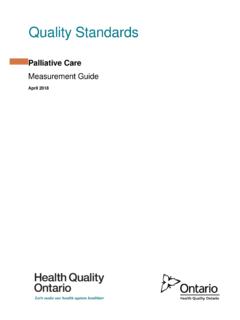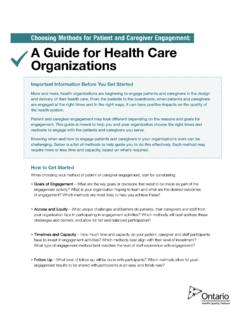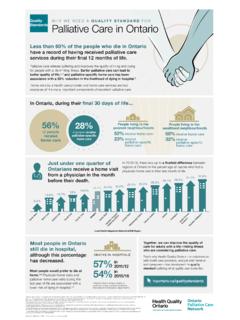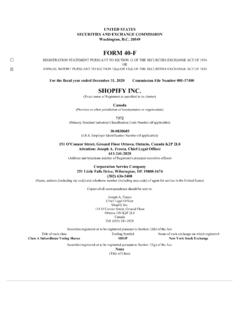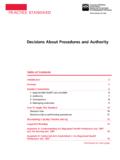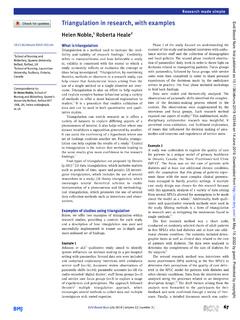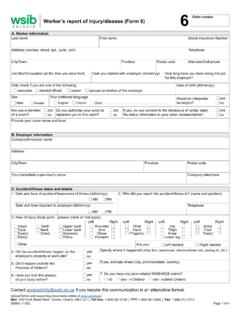Transcription of Ontario’s Patient Engagement Framework
1 ontario s Patient Engagement FrameworkCreating a strong culture of Patient Engagement to support high quality health careONTARIO S Patient Engagement FRAMEWORK2 Contents3 Engaging for Quality A Call to Action 6 About the Patient Engagement Framework8 Learn About the Guiding Principles for Engagement10 Identify the Different Domains for Patient Engagement 14 Learn About the Varying Approaches to Patient Engagement16 Find Out About the Enablers of Patient Engagement18 Put it all Together Engage Strategically for Better Quality CareONTARIO S Patient Engagement FRAMEWORK3 Engaging for Quality A Call to Action Across ontario , health care professionals, policy-makers, and organizations are actively engaging with patients, their families, other informal caregivers, and members of the public to understand their needs, experiences and prefer-ences to improve health care quality.
2 Engaging with patients and their caregivers transforms care. From reducing Emergency Department readmissionsi to increasing Patient safety and satisfactionii, involving patients and their loved ones in the conversation about how to improve health care quality generates important results for people receiving care, for health care professionals, and for the health system at-large. And the momentum for Engagement is only promote and support the drive for active Patient engage-ment, Health Quality ontario released the province s first Patient Engagement Framework in the fall of 2016, to define a common approach for Engagement across the province. Its purpose is to guide people in planning for, implementing and evaluating Patient Engagement activities across each of the health system s domains: in personal care and health decisions, in organizational program or service design, and in health care policy, strategy and governance.
3 Designed to ensure that patients and members of the public are able to make and influence decisions that affect their lives, the Framework is based on active consultation with more than 1,000 patients, caregivers and health care professionals from different regions, sectors and levels of the health system. The Framework also recognizes the unique Engagement needs and preferences of each of these groups and is based on leading research on Patient Engagement both within Canada and guide provides a short introduction to each part of the Framework , to support patients, caregivers and health professionals to engage effectively with each other. Working together, there is no limit to the quality of care that ontario can achieve. Patient Engagement means patients, family members and other informal caregivers, and health care professionals actively collaborating to improve health care quality in ontario .
4 It includes individual health care professionals, health care organizations and the province partnering with patients and their loved ones in different ways to understand their experiences, preferences and needs, and respond to them. When we say Patient , we are referring to patients cared for in hospitals, people being cared for in their homes or through com-munity programs, and residents living in long-term care S Patient Engagement FRAMEWORK4 ontario s Patient Engagement FrameworkTHE STRATEGIC GOALA strong culture of Patient , caregiver and public Engagement to support high quality health care THE GUIDING PRINCIPLESP ersonal careand health decisionsProgramand se rvice designPolicy, strategyand governanceACROSS THESE DOMAINSACROSS A SPECTRUM OF Engagement APPROACHESENABLED BY.
5 A culture of continuous quality improvement Commitment to health equity and cultural competence Rigorous research and evaluation Share ConsultCollaborate Deliberate LearningResponsivenessEmpowermentRespect PartnershipTransparencyAccess to easy-to-understand health informationProvide easy-to-understand health informationPartner to addressan issue and applysolutionsDiscuss an issueand exploresolutionsGet feedback on ahealth issue ( ,policy or decision) ontario S Patient Engagement FRAMEWORK5 ontario S Patient Engagement FRAMEWORK6 About the Patient Engagement FrameworkAbove is a snapshot of what the Framework entails, with explanations of each of its four sections to follow. To begin, the Framework starts with its purpose, or strategic goal: To create a strong culture for Patient , caregiver and public Engagement in ontario to support health care then highlights the core principles for success partnership, transparency, learning, responsiveness, empowerment and there, it goes on to clearly state that Engagement should occur across each domain of the health system when patients are making personal health care decisions with their health care professionals; when organizations are designing new programs and making improvements to existing services.
6 And when it comes to policy, strategy and governance to ensure a balanced Patient Engagement process within each Framework also highlights the spectrum of Engagement approaches from sharing, to consulting, to deliberating, to collaborating and recognizes that these approaches should be customized depending on the Engagement goals and setting, and that they often happen lastly, the Framework highlights the enablers that make high quality Engagement possible a dedication to continu-ous quality improvement; the provision of easy-to-understand information; a commitment to engaging all, including those from under-served populations; and rigorous research and evaluation to constantly learn from our s Patient Engagement Framework is designed toinspire action towards the ultimate goal a strong cultureof Engagement that drives continuously towards better care and better health for Ontarians.
7 With patients and caregivers as partners, there is no limit to the quality of care that ontario can S Patient Engagement FRAMEWORK7 ontario S Patient Engagement FRAMEWORK8 Learn About the Guiding Principles for EngagementHealth Quality ontario believes that six principles define a strong culture of Engagement between patients, their caregivers and health professionals. Each principle and the statement accompanying it are not meant to be compre-hensive, but are meant to spark discussion on the com-mitments necessary to bring about effective Engagement . Consider what each of these principles means and how you may be able to bring them to life in your Patient engage-ment work. They will help to ensure Engagement activities are meaningful to everyone six principles are: Partnership Meaningful Patient Engagement requires authentic, timely and mutually beneficial relationships forged between patients, their family members, other informal caregiv-ers, health professionals and the organizations they work with.
8 Learning All participants in Patient Engagement should expect to learn about each other s perspectives and expe-riences, about facts about the issue at hand, and about how things may improve and be better. Empowerment Patients and their caregivers need to feel empowered to openly express their needs, perspectives and concerns without fear of reprisal, and to make informed decisions with confidence. Transparency Transparency means that health care professionals and organizations are honest about their ap-prehensions, resource limitations, and knowledge gaps when it comes to engaging with patients and caregivers. Responsiveness - Being responsive means that health care professionals and organizations act upon the voices of patients, their caregivers and the general public in ways that demonstrate the positive impact of this.
9 Health care professionals and organizations demonstrate respect for their Patient and caregiver partners by actively showing signs of appreciation for their time, ideas, lived experiences, various worldviews and cultural S Patient Engagement FRAMEWORK9 ontario S Patient Engagement FRAMEWORK10 Identify the Different Domains for Patient Engagement Patients and caregivers should be meaningfully engaged to improve health care quality in different domains of care in personal care relationships between patients and their health care professionals, in organizational program and service design, and in policy, strategy and governance decisions. Differentiating between these domains will help to pinpoint priorities for Engagement . It is also helpful to consider all of the domains together to develop a comprehensive approach to an organization s Engagement activities, or the health system at A: Personal Care and Health Decisions Engaging in the domain of personal care and health decisions means health care professionals partner with patients and their caregivers in processes of shared decision-making and care.
10 For example, effective Engagement in this domain includes the ways patients, their caregivers, physicians, nurses and allied health professionals partner to ensure care plans best reflect a Patient s needs, wants, and circumstances. It also includes providing support for patients and caregivers to be effective members of a care team, by giving them education and supportive care professionals effectively engaging patients in their personal care and health decisions can lead to better and more trusting relationshipsiii, increased Patient activa-tion and capacity to manage health conditionsiv, adherence to a care plan, and ultimately better health outcomesvi Care and Health Decisions: Using Teach Back to Support Patient Care and Health Decision-MakingThrough ongoing health care staff training, Grey Bruce Health Services in Owen Sound empowers clinical staff to use teach back as a way of supporting Patient .




